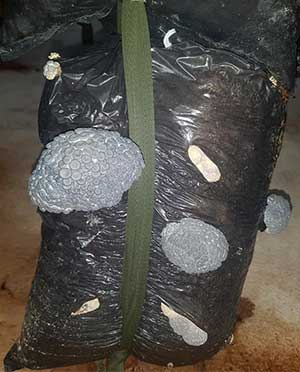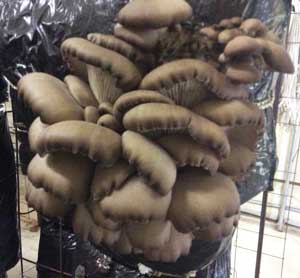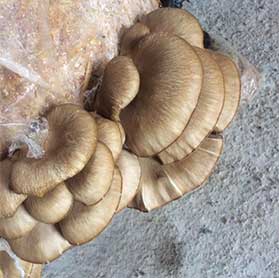
It doesn’t matter if you’re just getting started or have been growing mushrooms for years — sometimes, a problem pops up that leaves you scratching your head.
Your yield is low, and you start wondering what might have gone wrong. You ask fellow growers, you read articles, but somehow nothing quite fits your case...
In this article, I’ve put together a short list of common mistakes that can lead to disappointing yields.
It’s not a ranking — mistake number one isn’t necessarily more common than number six.
I simply arranged them in the order they appear during the process, from spawn to harvest.
Hopefully, this overview will help you find the weak link in your system — or at least give you a good place to start looking.
Online you’ll find plenty of videos showing how easy it is to grow spawn from a piece of mushroom.
What they rarely mention is that to maintain a clean, productive strain, you need proper lab conditions.
If you do want to make your own spawn for personal use, it’s much better to buy master spawn or a pure culture (liquid mycelium syringe) from a professional lab.
But sometimes the opposite happens. A beginner buys top-quality spawn from a lab — then makes “compost” from random ingredients, pours boiling water over it, and ends up with mold. The spawn gets blamed.
The mistake: blaming spawn quality without checking substrate preparation.
📌Read: How to determine the quality of grain spawn
This one’s simple: poor substrate leads to poor yields.
But how can you tell whether your substrate has enough nutrients or not?
Large farms usually send their raw materials to a lab for analysis before buying in bulk — checking nitrogen, phosphorus, and the carbon-to-nitrogen ratio.
But what if you're a small-scale grower, or just growing for yourself?
In that case, pay attention to the quality of the pins as they form. Here are two photos to show you what to look for.
Sometimes huge primordia (pins) form in one or two holes at once, while in other places they dry out without developing - as in the first photo.
That’s normal — the mycelium prioritizes where to send energy.


What’s not normal is when all the clusters are underdeveloped or dry out before fruiting. Or when each cluster only gives 1–3 mushrooms, and the rest abort.
Three likely causes:
✅Low nitrogen content in the substrate
✅Substrate that's either too dense, too loose, or at the wrong moisture level. Nutrients are delivered to the mushrooms via the mycelial network, and when structure or moisture is off, that transport system just doesn’t work well — resulting in lower yields.
✅Climate control issues (see #4)
The mistake: Overlooking both the nutrient balance and the physical properties of your substrate.
You can find charts online showing the nutrient content of different plant-based materials. Use them as a reference when designing your own substrate blends.
📌For more on suitable raw materials — and what physical properties a good substrate should have — check out my articles on oyster mushroom substrates.
If pins or small mushrooms die because of visible condensation, the drop in yield is easy to understand — you're literally watching the mushrooms die. I cover this in more detail here.
But in this article, I want to talk about a less obvious effect of condensation that can also reduce your yield.
When incubation conditions are unstable — with fluctuations in temperature and humidity — a thin layer of condensation can form inside many of the holes in the grow bags.
You might not even notice it, because there are no visible water droplets. But the mycelium near the openings gets too moist, and many hyphal knots never get the chance to turn into pins.
The mistake: not paying attention to stable incubation conditions can quietly cost you part of your harvest.
Incubation plays a big role in your future harvest.
📌There are many small but important things to know — I’ve covered them in my Incubation section
Poor ventilation, temperature swings, and unstable humidity all impact yield. You may get mushrooms, but they’ll be light, fragile, or thin-capped.
Sometimes growers think the climate “feels okay” — but stagnant air means CO₂ buildup. Or too much exhaust air dries the room out. Both scenarios hurt productivity.
The mistake: assuming your airflow, humidity & temperature is fine without measuring.
📌For a detailed guide on maintaining optimal growing conditions, check out my Growing Room Conditions section.
Out of all environmental parameters, humidity is the most critical — so it deserves a separate section.
If you match the right humidity level to the temperature in your grow room, you’ll get heavy clusters full of healthy mushrooms. But keep in mind that different strains may need slightly different levels.
You’ll often hear that “oyster mushrooms prefer around 85–88% humidity.” That’s a good starting point — but if that level is too low for your particular setup, your mushrooms may become stressed.
Signs include downward-curving caps, wrinkles or lumps along the edges, and a dry texture. And of course, this leads to yield loss.


The mistake: relying on the “standard” humidity range without reading the signs your mushrooms are giving you.
📌More about proper humidity levels here.
 At 19–20°C (66–68°F) and above, oyster mushrooms mature very fast — sometimes in just 10–12 hours.
At 19–20°C (66–68°F) and above, oyster mushrooms mature very fast — sometimes in just 10–12 hours.
You get mushrooms, but very little weight. If you wait too long, they start dropping spores and lose quality.
The caps become pale and thin, the texture soft.
Technically there’s a harvest, but it’s hard to sell.
The mistake: letting mushrooms overmature in warm conditions.
*Note that we’re talking here about common oyster mushrooms (Pleurotus ostreatus), which grow best at 14–18°C (57–64°F).
There are heat-tolerant varieties — like Pleurotus pulmonarius, pink oysters, or yellow oysters — that can feel perfectly fine at 23–26°C (73–79°F).
But even with these strains, one thing still holds true: if you don’t harvest them in time, they’ll quickly lose weight.
Even if your blocks produce well — if they sit in the fruiting room for weeks but only flush once, you lose time and space. Many commercial farms use strains designed to give almost all their yield in the first flush. After that, the blocks are removed.
This allows continuous cycles and better space efficiency. Holding on for a second flush might not be worth it.
The mistake: overestimating the value of second flushes in low-efficiency systems.
Every mistake above is fixable. Check your spawn quality, review your substrate recipe, and take a fresh look at your ventilation and humidity not just as “working,” but as systems that need to be dialed in.
📌And if you’re thinking of starting a small mushroom farm and wondering how much money you’ll need — I’ve got a detailed article on that topic too.
